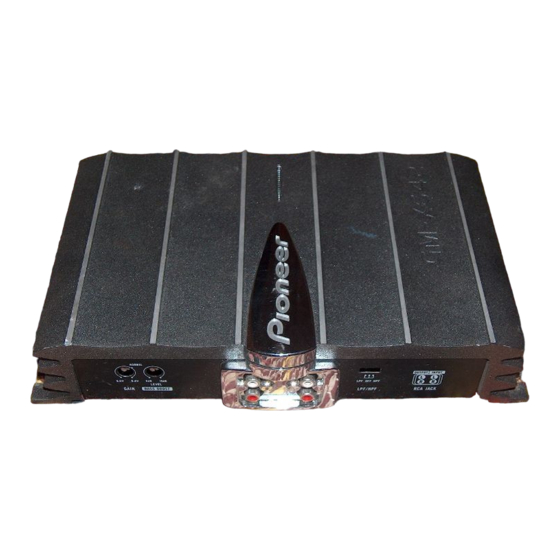Pioneer GM-X542 Manual del usuario - Página 3
Navegue en línea o descargue pdf Manual del usuario para Amplificador Pioneer GM-X542. Pioneer GM-X542 8 páginas. Bridgeable power amplifier
También para Pioneer GM-X542: Manual de servicio (26 páginas)

Connecting the Unit
Connecting the Power Terminal
4. Connect the wires to the terminal.
• Fix the wires securely with the terminal
• Always use the special red battery and ground
screws.
wire [RD-223], which is sold separately. Connect
the battery wire directly to the car battery positive
GND terminal
terminal (+) and the ground wire to the car body.
Power terminal
System remote
control terminal
1. Pass the battery wire from the
engine compartment to the interior
of the vehicle.
• After making all other connections to the
amplifier, connect the battery wire terminal of
the amplifier to the positive (+) terminal of
the battery.
Engine
Fuse (30 A)
compart-
Interior of
ment
the vehicle
Battery wire
Fuse (30 A)
Drill a 14 mm
Positive terminal
hole into the
vehicle body.
Insert the O-ring rubber
grommet into the vehicle
body.
2. Twist the battery wire, ground wire
and system remote control wire.
Twist
3. Attach lugs to wire ends. Lugs not
supplied.
• Use pliers, etc., to crimp lugs to wires.
Lug
Ground wire
Lug
Battery wire
Connecting the Speaker Terminals
4. Push on the terminal cover.
1. Expose the end of the speaker wires
by about 10 mm and twist using
nippers or a cutter.
Twist
System remote
control wire
10 mm
Ground wire
2. Attach lugs to speaker wire ends.
Lugs not supplied.
• Use pliers, etc., to crimp lugs to wires.
Lug
Speaker wire
3. Connect the speaker wires to the
speaker terminals.
• Connect the speaker wires, passing them
through the terminal cover.
• Fix the speaker wires securely with the termi-
nal screws.
Terminal screw
Terminal cover
Speaker
terminal
Speaker wire
Connecting the Speaker wires
The speaker output mode can be two-chan-
Three-channel mode, two-way system
nel (stereo), one-channel (mono), or three-
channel (stereo + mono). Connect the
speaker leads to suit the mode according to
the figures shown below.
• When either the RCA input or the speaker
C1
input is connected, RCA output becomes
functional. Do not connect both the RCA
input and the speaker input at the same time.
L1
Two-channel mode (stereo)
C1
(Right)
Speaker input
(Left)
+
≠
≠
+
Three-channel mode, three-way system
C1
L2
C2
+
≠
≠
+
(Left)
Speaker
L1
(Right)
L2
C2
One-channel mode (mono)
C1
(Right)
• Inductors (L1 and L2 in the diagrams)
Speaker input
(Left)
act as low-pass filters. Capacitors (C1
+
≠
≠
+
and C2 in the diagrams) act as high-pass
filters. Inductors (L) are used for the
woofer/subwoofer, and capacitors (C)
are used for the high/mid-high.
• Remember when bridging an amplifier it
will see only half of the original speaker
≠
+
impedance. Therefore, you must use
Speaker (Mono)
speakers that have ratings of 4 ohms or
higher. If you use speakers that have
lower impedance ratings it may cause
Three-channel mode (stereo + mono)
damage to the amplifier.
The power amplifier is basically a two-
• When the inductors and capacitors are
channel/one-channel bridgeable amplifier,
connected to the speaker wires, secure or
but three channels can be achieved by
solder them so they cannot be pulled
combining the stereo and mono modes
loose. Tape or use heat shrink on the
using inductors and capacitors.
joints to prevent short circuits.
Setting the Filter Constant
Low-pass filter (for subwoofer/woofer):
Band-pass filter (combination of low-pass
6 dB/octave
filter and high-pass filter for mid-
bass/mid): 6 dB/octave
0dB
L1
L2
–6dB
Mid-high (Left)
f
Woofer (Mono)
f
2f
C
C
Mid-high (Right)
High-pass filter (for mid/mid-high):
6 dB/octave
• A multi-channel system can be set up using a
combination of filters. The inductance (L) and
C1
0dB
capacitance (C) will determine the frequency (fc)
that the speaker will reproduce. Refer to the chart
–6dB
below to determine the components required.
• Use the capacitors specified. Non-polarized capac-
High/mid-high
f
itors rated at over ±25 V should be used for C1
f
f
C
C
(Left)
2
and C2 in the diagram. Because of the voltage
output of the amplifier, it is very important to use
Mid/mid-bass
non-polarized capacitors rated at or over 25 V.
(Left)
This will prevent a safety hazard.
Woofer/subwoofer
(Mono)
Mid/mid-bass
(Right)
Component Guide
High/mid-high
(Right)
Speaker load Impedance
2
fc (Hz)
L (mH)
C ( F)
50
6.4
1,600
80
4.0
1,000
125
2.5
640
200
1.6
400
320
1.0
250
500
0.64
160
800
0.4
100
1,250
0.25
64
2,000
0.16
40
3,200
0.1
25
5,000
0.06
16
8,000
0.04
10
10,000
0.03
8
C2
0dB
–6dB
f
f
f
2f
CL
CL
CH
CH
2
4
8
L (mH)
C ( F)
L (mH)
C ( F)
12.70
800.0
25.50
400.0
8.00
500.0
16.00
250.0
5.10
300.0
10.00
160.0
3.20
200.0
6.40
100.0
2.00
125.0
4.00
62.0
1.30
80.0
2.60
40.0
0.80
50.0
1.60
25.0
0.50
30.0
1.00
16.0
0.30
20.0
0.64
10.0
0.20
12.5
0.40
6.2
0.13
8.0
0.26
4.0
0.08
5.0
0.16
2.5
0.06
4.0
0.13
2.0
